POTASSIUM CHLORIDE injection, solution
Potassium Chloride by
Drug Labeling and Warnings
Potassium Chloride by is a Prescription medication manufactured, distributed, or labeled by ICU Medical Inc.. Drug facts, warnings, and ingredients follow.
Drug Details [pdf]
- SPL UNCLASSIFIED SECTION
- BOXED WARNING (What is this?)
- SPL UNCLASSIFIED SECTION
-
DESCRIPTION
This Potassium Chloride Injection is a sterile, nonpyrogenic, highly concentrated, ready-to-use solution of Potassium Chloride, USP in Water for Injection, USP for electrolyte replenishment in a single dose container for intravenous administration. It contains no antimicrobial agents.
Potassium
Chloride
Injection
mEq Potassium/
Container
Composition
(g/L)
Potassium
Chloride, USP
(KCl)
Osmolarity*
(mOsmol/L)
(calc)
pH
Ionic Concentration
(mEq/L)
Potassium
Chloride
10 mEq/100 mL
7.45
200
5.8
(4.0 to 8.0)
100
100
10 mEq/50 mL
20 mEq/100 mL
14.9
400
5.8
(4.0 to 8.0)
200
200
20 mEq/50 mL
40 mEq/100 mL
29.8
799
5.8
(4.0 to 8.0)
400
400
*Normal physiologic osmolarity range is approximately 280 to 310 mOsmol/L. Administration of substantially hypertonic solutions (≥600 mOsmol/L) may cause vein damage.
This flexible plastic container is fabricated from a specially formulated polyvinylchloride. Exposure to temperatures above 25°C (77°F) during transport and storage will lead to minor losses in moisture content. Higher temperatures lead to greater losses. It is unlikely that these minor losses will lead to clinically significant changes within the expiration period. The amount of water that can permeate from inside the container into the overwrap is insufficient to affect the solution significantly. Solutions in contact with the plastic container may leach out certain of its chemical components from the plastic in very small amounts; however, biological testing was supportive of the safety of the plastic container materials.
-
CLINICAL PHARMACOLOGY
Potassium is the major cation of body cells (160 mEq/liter of intracellular water) and is concerned with the maintenance of body fluid composition and electrolyte balance. Potassium participates in carbohydrate utilization, protein synthesis, and is critical in the regulation of nerve conduction and muscle contraction, particularly in the heart. Chloride, the major extracellular anion, closely follows the metabolism of sodium, and changes in the acid-base of the body are reflected by changes in the chloride concentration.
Normally about 80 to 90% of the potassium intake is excreted in the urine, the remainder in the stools and to a small extent, in the perspiration. The kidney does not conserve potassium well so that during fasting, or in patients on a potassium-free diet, potassium loss from the body continues resulting in potassium depletion. A deficiency of either potassium or chloride will lead to a deficit of the other.
-
INDICATIONS AND USAGE
Potassium Chloride Injection is indicated in the treatment of potassium deficiency states when oral replacement is not feasible.
THIS HIGHLY CONCENTRATED, READY-TO-USE POTASSIUM CHLORIDE INJECTION IS INTENDED FOR THE MAINTENANCE OF SERUM K + LEVELS AND FOR POTASSIUM SUPPLEMENTATION IN FLUID RESTRICTED PATIENTS WHO CANNOT ACCOMMODATE ADDITIONAL VOLUMES OF FLUID ASSOCIATED WITH POTASSIUM SOLUTIONS OF LOWER CONCENTRATION.
When using these products, these patients should be on continuous cardiac monitoring and frequent testing for serum potassium concentration and acid-base balance.
- CONTRAINDICATIONS
-
WARNINGS
THIS HIGHLY CONCENTRATED, READY-TO-USE POTASSIUM CHLORIDE INJECTION IS INTENDED FOR THE MAINTENANCE OF SERUM K + LEVELS AND FOR POTASSIUM SUPPLEMENTATION IN FLUID RESTRICTED PATIENTS WHO CANNOT ACCOMMODATE ADDITIONAL VOLUMES OF FLUID ASSOCIATED WITH POTASSIUM SOLUTIONS OF LOWER CONCENTRATION.
TO AVOID POTASSIUM INTOXICATION, DO NOT INFUSE THESE SOLUTIONS RAPIDLY.
PATIENTS REQUIRING HIGHLY CONCENTRATED SOLUTIONS SHOULD BE KEPT ON CONTINUOUS CARDIAC MONITORING AND UNDERGO FREQUENT TESTING FOR SERUM POTASSIUM AND ACID-BASE BALANCE, ESPECIALLY IF THEY RECEIVE DIGITALIS.
In patients with renal insufficiency, administration of potassium chloride may cause potassium intoxication and life-threatening hyperkalemia.
Administer intravenously only with a calibrated infusion device at a slow, controlled rate. (See DOSAGE AND ADMINISTRATION.) Because pain associated with peripheral infusion of Potassium Chloride solution has been reported, whenever possible administration via a central route is recommended for thorough dilution by the blood stream and avoidance of extravasation. Highest concentrations (300 and 400 mEq/L) should be exclusively administered via central route.
The administration of intravenous solutions can cause fluid and/or solute overload resulting in dilution of serum electrolyte concentrations, overhydration, congested states or pulmonary edema. The risk of dilutional states is inversely proportional to the electrolyte concentration. The risk of solute overload causing congested states with peripheral and pulmonary edema is directly proportional to the electrolyte concentration.
-
PRECAUTIONS
Laboratory Tests
Serum potassium levels are not necessarily indicative of tissue potassium levels. Solutions containing potassium should be used with caution in the presence of cardiac or renal disease.
Clinical evaluation and periodic laboratory determinations are necessary to monitor changes in fluid balance, electrolyte concentrations, and acid-base balance during prolonged parenteral therapy or whenever the condition of the patient warrants such evaluation. Significant deviations from normal concentrations may require the use of additional electrolyte supplements, or the use of electrolyte-free dextrose solutions to which individualized electrolyte supplements may be added.
Pregnancy:
Pregnancy Category C. Animal reproduction studies have not been conducted with potassium chloride. It is also not known whether potassium chloride can cause fetal harm when administered to a pregnant woman or can affect reproduction capacity. Potassium chloride should be given to a pregnant woman only if clearly needed.
-
ADVERSE REACTIONS
Potassium intoxication with mild or severe hyperkalemia has been reported. The signs and symptoms of intoxication include paresthesia of the extremities, areflexia, muscular or respiratory paralysis, mental confusion, weakness, hypotension, cardiac arrhythmia, heart block, electrographic abnormalities and cardiac arrest. EKG abnormalities serve as a clinical reflection of the seriousness of changes in serum potassium concentrations: peaked T waves and prolonged P-R intervals usually occur with modest elevations above the upper limit of normal potassium concentrations; P waves disappear, the QRS complex widens, and eventual asystole usually occurs with higher elevations.
Reactions which may occur because of the solution or the technique of administration include febrile response, infection at the site of injection, venous thrombosis or phlebitis extending from the site of injection, extravasation and hypervolemia.
Infusion of highly concentrated potassium chloride solutions may cause local pain and vein irritation. (See WARNINGS).
Reactions reported with the use of potassium-containing solutions include nausea, vomiting, and abdominal pain and diarrhea.
If an adverse reaction does occur, discontinue the infusion, evaluate the patient, institute appropriate therapeutic countermeasures and save the remainder of the fluid for examination if deemed necessary.
-
OVERDOSAGE
In the event of hyperkalemia, discontinue the infusion immediately and institute corrective therapy to reduce serum potassium levels as necessary. The use of potassium containing foods or medications must also be eliminated.
Treatment of mild to severe hyperkalemia with signs and symptoms of potassium intoxication includes the following:
-
Dextrose Injection, USP, 10% or 25%, containing 10 units of crystalline insulin per 20 grams of dextrose administered intravenously, 300 to 500 mL per hour.
-
Absorption and exchange of potassium using sodium or ammonium cycle cation exchange resin, orally and as retention enema.
-
Hemodialysis and peritoneal dialysis.
In cases of digitalization, too rapid a lowering of plasma potassium concentration can cause digitalis toxicity.
-
-
DOSAGE AND ADMINISTRATION
The dose and rate of administration are dependent upon the specific condition of each patient.
Administer intravenously only with a calibrated infusion device at a slow, controlled rate. Because pain associated with peripheral infusion of Potassium Chloride solution has been reported, whenever possible, administration via central route is recommended for thorough dilution by the blood stream and avoidance of extravasation. Highest concentrations (300 and 400 mEq/L) should be exclusively administered via central route.
Recommended administration rates should not usually exceed 10 mEq/hour or 200 mEq for a 24-hour period if the serum potassium level is greater than 2.5 mEq/liter.
In urgent cases where the serum potassium level is less than 2 mEq/liter or where severe hypokalemia is a threat (serum potassium level less than 2 mEq/liter and electrocardiographic changes and/or muscle paralysis), rates up to 40 mEq/hour or 400 mEq over a 24-hour period can be administered very carefully when guided by continuous monitoring of the EKG and frequent serum K+ determinations to avoid hyperkalemia and cardiac arrest.
Parenteral drug products should be inspected visually for particulate matter and discoloration, whenever solution and container permit. Use of a final filter is recommended during administration of all parenteral solutions where possible.
Do not add supplementary medication.
Preparation for Administration
(Use aseptic technique)
-
Close flow control clamp of administration set.
-
Remove cover from outlet port at bottom of container.
-
Insert piercing pin of administration set into port with a twisting motion until the set is firmly seated. NOTE: See full directions on administration set carton.
-
Suspend container from hanger.
-
Squeeze and release drip chamber to establish proper fluid level in chamber.
-
Open flow control clamp and clear air from set. Close clamp.
-
Attach set to venipuncture device. If device is not indwelling, prime and make venipuncture.
-
Regulate rate of administration with flow control clamp.
WARNING: Do not use flexible container in series connections. Do not add supplementary medication. Such use could result in air embolism due to residual air being drawn from the primary container before administration of the fluid from the secondary container is completed.
-
-
HOW SUPPLIED
Potassium Chloride Injection in flexible plastic containers is available as follows:
NDC No.
Potassium per container
0409–7074–26
10 mEq/100 mL
0990-7074-26 10 mEq/100 mL 0409–7075–14
10 mEq/50 mL
0990-7075-14 10 mEq/50 mL 0409–7075–26
20 mEq/100 mL
0990-7075-26 20 mEq/100 mL 0409–7077–14
20 mEq/50 mL
0990-7077-14 20 mEq/50 mL 0409–7077–26
40 mEq/100 mL
0990-7077-26 40 mEq/100 mL ICU Medical is transitioning NDC codes from "0409" to a "0990" labeler code. Both NDC codes are expected to be in the market for a period of time.
Store at 20 to 25°C (68 to 77°F). [See USP Controlled Room Temperature.]
Revised: June, 2018
EN-4654
ICU Medical, Inc., Lake Forest, Illinois, 60045, USA
- CLINICAL STUDIES
-
PRINCIPAL DISPLAY PANEL - 100 mL Bag Label
For Use Only With A Calibrated Infusion Device
Highly Concentrated
100 mEq/L100 mL
NDC: 0990-7074-26POTASSIUM CHLORIDE Inj.
10
mEqEACH 100 mL CONTAINS POTASSIUM CHLORIDE
745 mg IN WATER FOR INJECTION. ELECTROLYTES
PER 1000 mL: POTASSIUM 100 mEq; CHLORIDE
100 mEq.
200 mOsmol/LITER (CALC.)
pH 5.8 (4.0 to 8.0)DO NOT ADD SUPPLEMENTARY MEDICATION.
WHENEVER POSSIBLE USE CENTRAL ROUTE.SINGLE-DOSE CONTAINER. FOR I.V. USE. USUAL
DOSAGE: SEE INSERT. STERILE, NONPYROGENIC.
USE ONLY IF SOLUTION IS CLEAR AND CONTAINER
IS UNDAMAGED. MUST NOT BE USED IN SERIES
CONNECTIONS.Rx ONLY
3
V
CONTAINS DEHPICU Medical, Inc.,
Lake Forest, Illinois, 60045, USAicumedical
IM-4339
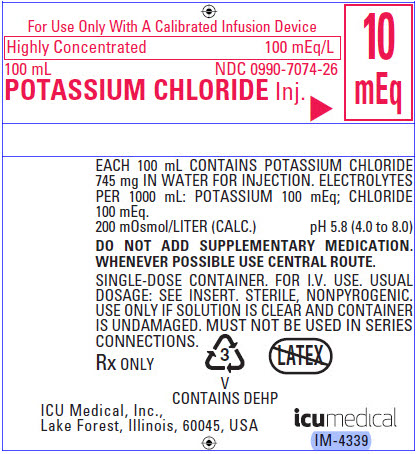
-
PRINCIPAL DISPLAY PANEL - 100 mL Bag Pouch Label
TO OPEN – TEAR AT NOTCH
NDC: 0990-7074-26
For use only with a calibrated infusion device.
HIGHLY CONCENTRATED100
mEq/LPOTASSIUM
CHLORIDE Inj.10
mEqTotal in 100 mL
Each 100 mL contains potassium chloride 745 mg in water for injection.
Electrolytes per 1000 mL: potassium 100 mEq; chloride 100 mEq.
200 mOsmol/liter (CALC.)
pH 5.8 (4.0 to 8.0)DO NOT ADD SUPPLEMENTARY MEDICATION. WHENEVER POSSIBLE USE
CENTRAL ROUTE.Single-dose container. For I.V. use. Usual dosage: See insert. Sterile, nonpyrogenic.
Use only if solution is clear. After removing the overwrap, check for minute leaks
by squeezing container firmly. If leaks are found, discard unit as sterility may be
impaired. Must not be used in series connections.The overwrap is a moisture barrier. Do not remove unit from overwrap until ready
for use. Use unit promptly when pouch is opened. Store at 20 to 25°C (68 to 77°F). [See
USP Controlled Room Temperature.] Protect from freezing. See insert.Rx only
7
OTHERF WR-0529
ICU Medical, Inc., Lake Forest, Illinois, 60045, USA
icumedical
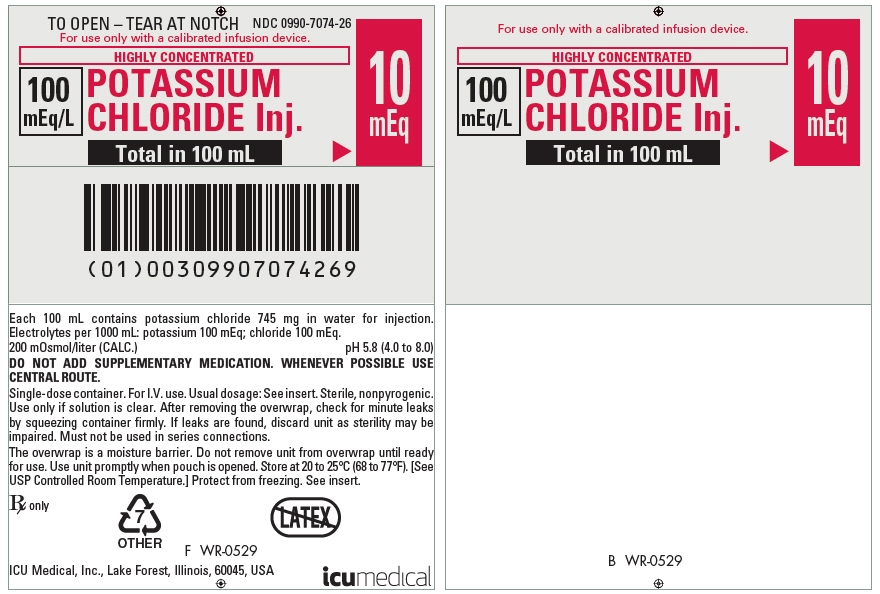
-
PRINCIPAL DISPLAY PANEL - 50 mL Bag Label - IM-4340
For Use Only With A Calibrated Infusion Device
Highly Concentrated
200 mEq/L50 mL
NDC: 0990-7075-14POTASSIUM CHLORIDE Inj.
10
mEqEACH 100 mL CONTAINS POTASSIUM CHLORIDE
1490 mg IN WATER FOR INJECTION. ELECTROLYTES
PER 1000 mL: POTASSIUM 200 mEq; CHLORIDE
200 mEq.
400 mOsmol/LITER (CALC.)
pH 5.8 (4.0 to 8.0)DO NOT ADD SUPPLEMENTARY MEDICATION.
WHENEVER POSSIBLE USE CENTRAL ROUTE.SINGLE-DOSE CONTAINER. USUAL DOSAGE: SEE
INSERT. FOR I.V. USE. STERILE, NONPYROGENIC.
USE ONLY IF SOLUTION IS CLEAR AND CONTAINER
IS UNDAMAGED. MUST NOT BE USED IN SERIES
CONNECTIONS.Rx ONLY
3
V
CONTAINS DEHPicumedical
IM-4340
ICU Medical, Inc., Lake Forest, Illinois, 60045, USA
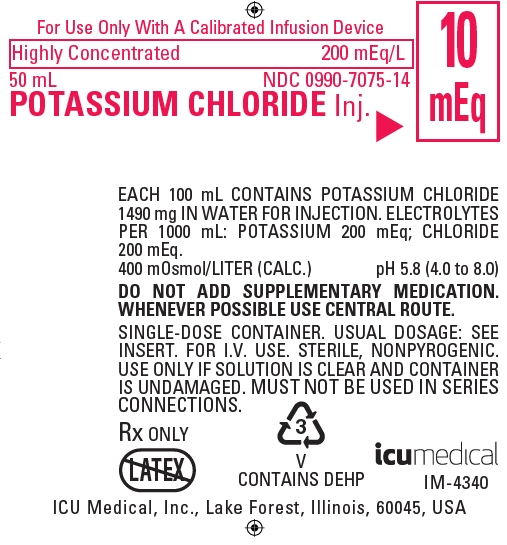
-
PRINCIPAL DISPLAY PANEL - 50 mL Bag Pouch Label - WR-0530
TO OPEN – TEAR AT NOTCH
NDC: 0990-7075-14
For use only with a calibrated infusion device.
HIGHLY CONCENTRATED200
mEq/LPOTASSIUM
CHLORIDE Inj.10
mEqTotal in 50 mL
Each 100 mL contains potassium chloride 1490 mg in water for injection.
Electrolytes per 1000 mL: potassium 200 mEq; chloride 200 mEq.
400 mOsmol/liter (CALC.)
pH 5.8 (4.0 to 8.0)DO NOT ADD SUPPLEMENTARY MEDICATION. WHENEVER POSSIBLE USE
CENTRAL ROUTE.Single-dose container. For I.V. use. Usual dosage: See insert. Sterile, nonpyrogenic.
Use only if solution is clear. After removing the overwrap, check for minute leaks
by squeezing container firmly. If leaks are found, discard unit as sterility may be
impaired. Must not be used in series connections.The overwrap is a moisture barrier. Do not remove unit from overwrap until ready
for use. Use unit promptly when pouch is opened. Store at 20 to 25°C (68 to 77°F).
[See USP Controlled Room Temperature.] Protect from freezing. See insert.Rx only
7
OTHERF WR-0530
ICU Medical, Inc., Lake Forest, Illinois, 60045, USA
icumedical
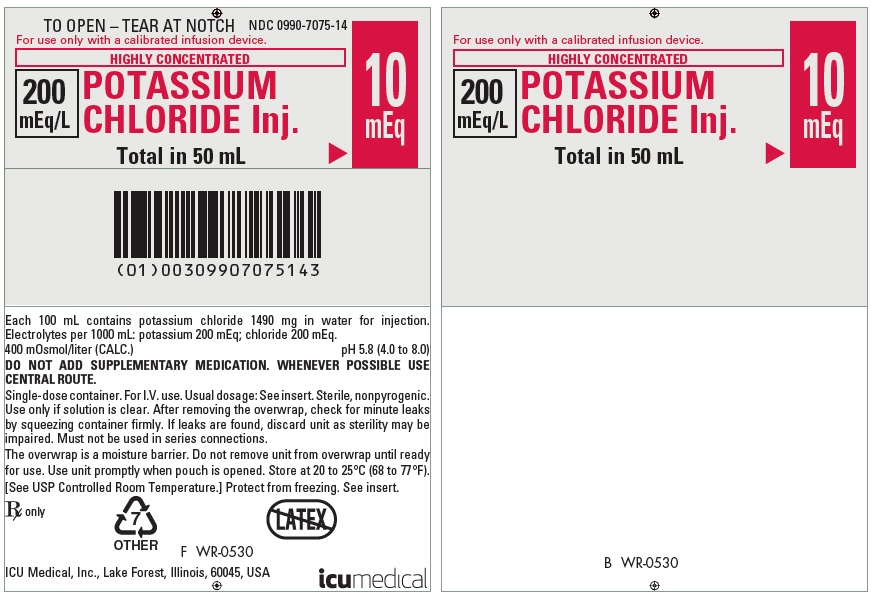
-
PRINCIPAL DISPLAY PANEL - 50 mL Bag Label - IM-4342
For Use Only With A Calibrated Infusion Device
Highly Concentrated
400 mEq/L50 mL
NDC: 0990-7077-14POTASSIUM CHLORIDE Inj.
20
mEqEACH 50 mL CONTAINS POTASSIUM CHLORIDE
1.49 g IN WATER FOR INJECTION. ELECTROLYTES
PER 1000 mL: POTASSIUM 400 mEq; CHLORIDE
400 mEq.
799 mOsmol/LITER (CALC.)
pH 5.8 (4.0 to 8.0)
HYPERTONIC – MAY CAUSE VEIN DAMAGE.
DO NOT ADD SUPPLEMENTARY MEDICATION.
WHENEVER POSSIBLE USE CENTRAL ROUTE.
DISCONTINUE INFUSION IF ADVERSE REACTION
OCCURS. SINGLE-DOSE CONTAINER. FOR I.V.
USE. USUAL DOSAGE: SEE INSERT. STERILE,
NONPYROGENIC. USE ONLY IF SOLUTION IS CLEAR
AND CONTAINER IS UNDAMAGED. MUST NOT BE
USED IN SERIES CONNECTIONS.Rx ONLY
3
V
CONTAINS DEHPICU Medical, Inc.,
Lake Forest, Illinois, 60045, USAIM-4342
icumedical

-
PRINCIPAL DISPLAY PANEL - 50 mL Bag Pouch Label - WR-0536
TO OPEN – TEAR AT NOTCH
NDC: 0990-7077-14
For use only with a calibrated infusion device.
HIGHLY CONCENTRATED20
mEqPOTASSIUM
CHLORIDE Inj.400
mEq/LTotal in 50 mL
Each 50 mL contains potassium chloride 1.49 g in water for injection. Electrolytes
per 1000 mL: potassium 400 mEq; chloride 400 mEq.
799 mOsmol/liter (CALC.)
pH 5.8 (4.0 to 8.0)
Hypertonic – may cause vein damage.DO NOT ADD SUPPLEMENTARY MEDICATION. WHENEVER POSSIBLE USE
CENTRAL ROUTE.Discontinue infusion if adverse reaction occurs.
Single-dose container. For I.V. use. Usual dosage: See insert. Sterile, nonpyrogenic.
Use only if solution is clear. After removing the overwrap, check for minute leaks by
squeezing container firmly. If leaks are found, discard unit as sterility may be impaired.
Must not be used in series connections.The overwrap is a moisture barrier. Do not remove unit from overwrap until ready
for use. Use unit promptly when pouch is opened. Store at 20 to 25°C (68 to 77°F).
[See USP Controlled Room Temperature.] Protect from freezing. See insert.Rx only
7
OTHERF WR-0536
ICU Medical, Inc., Lake Forest, Illinois, 60045, USA
icumedical
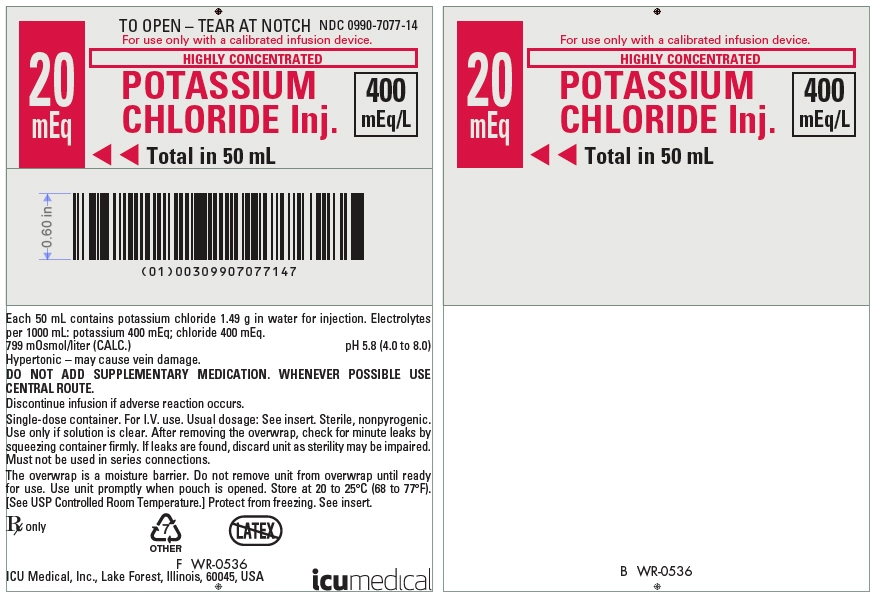
-
INGREDIENTS AND APPEARANCE
POTASSIUM CHLORIDE
potassium chloride injection, solutionProduct Information Product Type HUMAN PRESCRIPTION DRUG Item Code (Source) NDC: 0990-7074 Route of Administration INTRAVENOUS Active Ingredient/Active Moiety Ingredient Name Basis of Strength Strength POTASSIUM CHLORIDE (UNII: 660YQ98I10) (POTASSIUM CATION - UNII:295O53K152, CHLORIDE ION - UNII:Q32ZN48698) POTASSIUM CHLORIDE 10 meq in 100 mL Inactive Ingredients Ingredient Name Strength WATER (UNII: 059QF0KO0R) Packaging # Item Code Package Description Marketing Start Date Marketing End Date 1 NDC: 0990-7074-26 24 in 1 CASE 05/01/2019 1 1 in 1 POUCH 1 100 mL in 1 BAG; Type 0: Not a Combination Product Marketing Information Marketing Category Application Number or Monograph Citation Marketing Start Date Marketing End Date NDA NDA020161 04/01/2019 POTASSIUM CHLORIDE
potassium chloride injection, solutionProduct Information Product Type HUMAN PRESCRIPTION DRUG Item Code (Source) NDC: 0990-7075 Route of Administration INTRAVENOUS Active Ingredient/Active Moiety Ingredient Name Basis of Strength Strength POTASSIUM CHLORIDE (UNII: 660YQ98I10) (POTASSIUM CATION - UNII:295O53K152, CHLORIDE ION - UNII:Q32ZN48698) POTASSIUM CHLORIDE 200 meq in 1000 mL Inactive Ingredients Ingredient Name Strength WATER (UNII: 059QF0KO0R) Packaging # Item Code Package Description Marketing Start Date Marketing End Date 1 NDC: 0990-7075-14 24 in 1 CASE 04/01/2019 1 1 in 1 POUCH 1 50 mL in 1 BAG; Type 0: Not a Combination Product 2 NDC: 0990-7075-26 24 in 1 CASE 04/01/2019 2 1 in 1 POUCH 2 100 mL in 1 BAG; Type 0: Not a Combination Product Marketing Information Marketing Category Application Number or Monograph Citation Marketing Start Date Marketing End Date NDA NDA020161 04/01/2019 POTASSIUM CHLORIDE
potassium chloride injection, solutionProduct Information Product Type HUMAN PRESCRIPTION DRUG Item Code (Source) NDC: 0990-7077 Route of Administration INTRAVENOUS Active Ingredient/Active Moiety Ingredient Name Basis of Strength Strength POTASSIUM CHLORIDE (UNII: 660YQ98I10) (POTASSIUM CATION - UNII:295O53K152, CHLORIDE ION - UNII:Q32ZN48698) POTASSIUM CHLORIDE 400 meq in 1000 mL Inactive Ingredients Ingredient Name Strength WATER (UNII: 059QF0KO0R) Packaging # Item Code Package Description Marketing Start Date Marketing End Date 1 NDC: 0990-7077-14 24 in 1 CASE 06/01/2019 1 1 in 1 POUCH 1 50 mL in 1 BAG; Type 0: Not a Combination Product 2 NDC: 0990-7077-26 24 in 1 CASE 12/31/2019 2 1 in 1 POUCH 2 100 mL in 1 BAG; Type 0: Not a Combination Product Marketing Information Marketing Category Application Number or Monograph Citation Marketing Start Date Marketing End Date NDA NDA020161 04/01/2019 Labeler - ICU Medical Inc. (118380146)
© 2026 FDA.report
This site is not affiliated with or endorsed by the FDA.